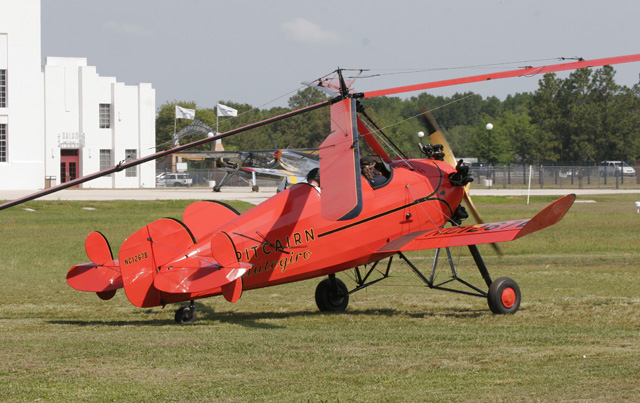
1934 Pitcairn Autogiro PA-18
This eye-catching and unique aircraft is much more than a blip in the evolution of aviation.
In fact it represents a critical breakthrough conceived by true innovator Juan de la Cierva (born 1895), who was interested in eliminating the stall/spin problem of fixed-wing aircraft in the early 1920s. What emerged from his experiments was the Autogiro. Cierva was specific in the spelling of the trademarked device: “giro” not “gyro,” since it does not employ gyroscopic forces. Instead, it overcomes them through the use of flapping hinges on the rotors. Having each blade hinged at the root allows the rotor system to equalize lift around the entire rotor disk. The hinge allows the advancing blade to rise while the retreating blade descends. As a result the aircraft can descend almost vertically with no risk of stalling.
These so-called “windmill planes” caught on in Europe late in the ‘20s, convincing American aircraft builder Harold Pitcairn to get in on the act and obtain a license to build dozens of them in the U.S., many of which were used to advertize popular products such as Coca-Cola, Beech-Nut, and Champion Spark Plugs—making them expensive celebrity-toned aircraft, costing as much as eight times the average annual income of the average person. However, the one before you was reserved as the personal aircraft of Pitcairn himself through the mid-‘30s. After passing through several sets of hands during subsequent decades and suffering from weather exposure and theft, in 1999 it fell into the hands of aircraft restorer Jack Tiffany who, with a band of friends, a lot of patience, some profound research skills, and a bucket of money and luck, had it flying after “only” nine years of hard restoration work.
Specifications
- Year Built — 1932
- Length — 19’5″
- Height — 11’4″
- Rotor Diameter — 40′
- Top Speed — 100 mph
- Engine — Kinner R5 (160 hp)
Kermit’s Comments
Even though I have a helicopter rating, I still needed to get a gyro-plane rating as well to fly the autogiro since the operation of it is totally different. This was all prompted by acquiring this remarkable airplane, which introduced me to the band of restorers who have worked diligently to preserve the genius of Cierva and the legacy he had on aviation. The added bonus is that I now have a resource for have my Cierva Autogiro restored! Plus, if you look closely, I’m sure you will see the potential of a new character for my Golden Age series of books for children. Meet Juan!